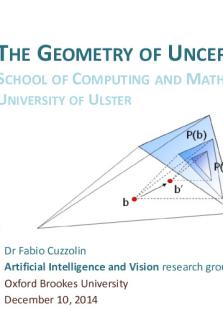Uncertainty Reduction Theory PDF

| Title | Uncertainty Reduction Theory |
|---|---|
| Author | Xenna Smith |
| Course | Introduction to Communication Theory |
| Institution | North Carolina State University |
| Pages | 2 |
| File Size | 35.6 KB |
| File Type | |
| Total Downloads | 24 |
| Total Views | 139 |
Summary
Notes on Uncertainty Reduction Theory in communication ...
Description
Uncertainty Reduction Theory: An Introduction ● ●
Berger and Calabrese developed uncertainty reduction theory (URT) to explain how individuals use communication to reduce the uncertainty of initial interactions People have two main goals in initial interactions: prediction and explanation
Assumptions of URT ● ● ● ●
● ●
People experience uncertainty in interpersonal settings Uncertainty is an aversive state, generating cognitive stress When strangers meet, their primary concern is to reduce uncertainty and increase predictability Interpersonal communication is a developmental process that occurs in stages ○ Entry Phase ○ Personal Phase ○ Exit Phase The quantity and nature of information that people share changes over time It is possible to predict people’s behavior in a law-like fashion
Axioms of URT ●
Axioms-- Truisms drawn from past research and common sense ○ 1: The more you talk to someone the uncertainty decreases ○ 2: The more positive nonverbal communication the less the uncertainty ○ 3: High levels of uncertainty cause increases in information seeking ○ 4: High levels of uncertainty in a relationship cause decreases in the intimacy level of communication content ○ 5: High levels of uncertainty produce high rates of reciprocity ○ 6: Similarities between people reduce uncertainty and the other way around ○ 7: Increases in uncertainty level produce decreases in liking
Expansions of URT ●
●
Strategies to reduce uncertainty ○ Passive--Observing ○ Active--Asking others or observing a response to a manipulation ○ Interactive--Engaging directly Relational uncertainty ○ Self uncertainty ○ Partner ○ Relationship
Uncertainty Management Theory (UMT) ● ●
●
●
●
Brashers based Uncertainty Management Theory on URT Assumptions of UMT ○ LIfe is unpredictable ○ Reducing uncertainty is just one option for individuals faced with uncertainty ○ Some may choose to maintain or increase uncertainty to stay hopeful or optimistic UMT Tenant 2 ○ Reactions to uncertainty are predicated on emotions and appraisals ○ Appraisal Theory: evaluations of events based on relevance and likelihood of an event ○ Individuals appraise events in part on their emotional reactions to events ○ If a situation elicits positive emotions, then uncertainty likely will be evaluated positively ○ If a situation elicits negative emotions, then uncertainty likely will be evaluated negatively ○ If a situation does not elicit emotions then uncertainty will be appraised as inconsequential UMT Tenant 1 ○ People experience uncertainty when they perceive situations as ambiguous, complex, unpredictable, or probabilistic UMT Tenant 3 ○ Uncertainty management strategies are chosen based on appraisals ■ Uncertainty as an opportunity: avoid information/experiences or seek conflicting information ■ Uncertainty as a threat: seek information ■ Uncertainty as a chronic condition: learn to tolerate uncertainty
UMT and Genetic Testing ●
Huntington’s Disease--inherited brain condition in which an individual slowly loses control of their body
Critiques ● ●
Limitations: questions of validity Strengths: Heuristic, parsimonious, stood test of time...
Similar Free PDFs

Uncertainty reduction theory
- 7 Pages

Uncertainty Reduction Theory
- 2 Pages

Chapter 05 Uncertainty Analysis
- 39 Pages

2. Choice under uncertainty
- 8 Pages

Decision making under uncertainty
- 21 Pages

Ch4 Estimating with Uncertainty
- 1 Pages

THE GEOMETRY OF UNCERTAINTY
- 80 Pages

Lecture 2 Risk and Uncertainty
- 30 Pages

Lesson Plan - certainty uncertainty
- 14 Pages

Cone of Uncertainty
- 7 Pages
Popular Institutions
- Tinajero National High School - Annex
- Politeknik Caltex Riau
- Yokohama City University
- SGT University
- University of Al-Qadisiyah
- Divine Word College of Vigan
- Techniek College Rotterdam
- Universidade de Santiago
- Universiti Teknologi MARA Cawangan Johor Kampus Pasir Gudang
- Poltekkes Kemenkes Yogyakarta
- Baguio City National High School
- Colegio san marcos
- preparatoria uno
- Centro de Bachillerato Tecnológico Industrial y de Servicios No. 107
- Dalian Maritime University
- Quang Trung Secondary School
- Colegio Tecnológico en Informática
- Corporación Regional de Educación Superior
- Grupo CEDVA
- Dar Al Uloom University
- Centro de Estudios Preuniversitarios de la Universidad Nacional de Ingeniería
- 上智大学
- Aakash International School, Nuna Majara
- San Felipe Neri Catholic School
- Kang Chiao International School - New Taipei City
- Misamis Occidental National High School
- Institución Educativa Escuela Normal Juan Ladrilleros
- Kolehiyo ng Pantukan
- Batanes State College
- Instituto Continental
- Sekolah Menengah Kejuruan Kesehatan Kaltara (Tarakan)
- Colegio de La Inmaculada Concepcion - Cebu





